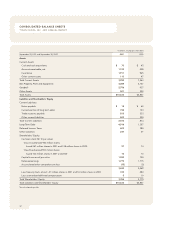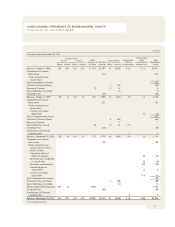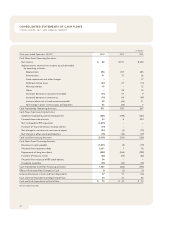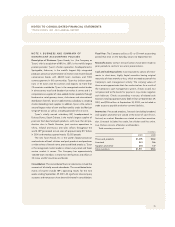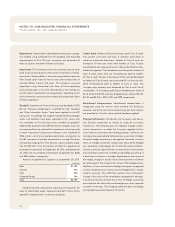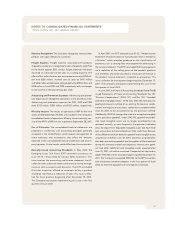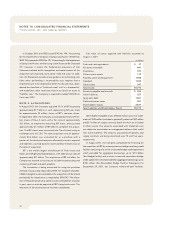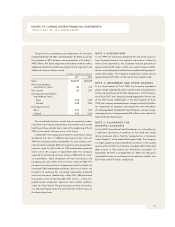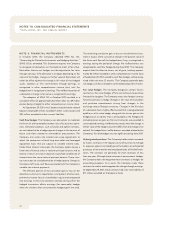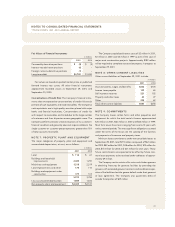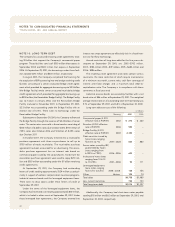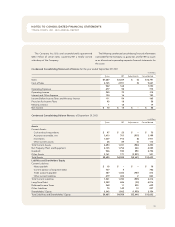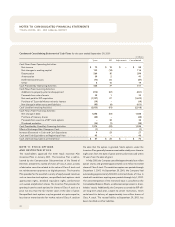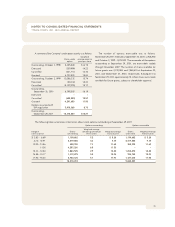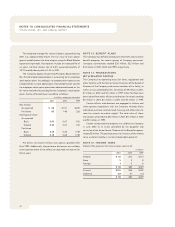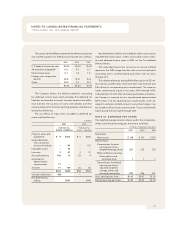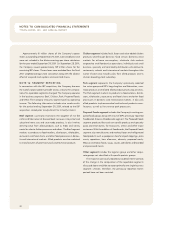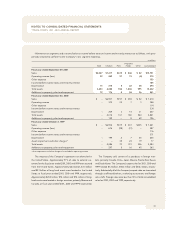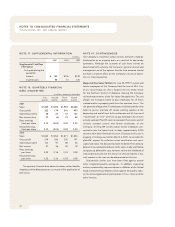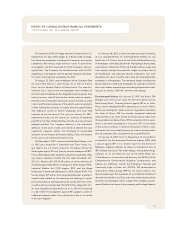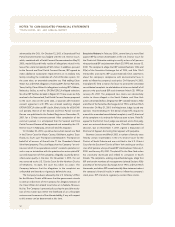Tyson Foods 2001 Annual Report Download - page 44
Download and view the complete annual report
Please find page 44 of the 2001 Tyson Foods annual report below. You can navigate through the pages in the report by either clicking on the pages listed below, or by using the keyword search tool below to find specific information within the annual report.
42
NOTES TO CONSOLIDATED FINANCIAL STATEMENTS
TYSON FOODS, INC. 2001 ANNUAL REPORT
NOTE 10: LONG-TERM DEBT
The Company has unsecured revolving credit agreements total-
ing $1 billion that support the Company’s commercial paper
program. These facilities consist of $500 million that expires in
September 2002 and $500 million that expires in September
2006. At September 29, 2001, the borrowings under these facil-
ities totaled $210 million and $500 million, respectively.
In August 2001, the Company completed the financing for
the acquisition of IBP by entering into two bridge revolving credit
facilities consisting of a senior unsecured bridge credit agree-
ment which provided for aggregate borrowings up to $2.5 billion
(the Bridge Facility) and a senior unsecured receivables bridge
credit agreement which provided for aggregate borrowings up
to $350 million (the Receivables Bridge Facility). The Bridge Facility
was to mature in January 2002, and the Receivables Bridge
Facility matured in November 2001. At September 29, 2001,
$2.3 billion was outstanding under the Bridge Facility with an
interest rate of 4.01%. There were no borrowings under the
Receivables Bridge Facility.
Subsequent to September 29, 2001, the Company refinanced
the Bridge Facility through the issuance of $2.25 billion of senior
notes. The senior notes were sold in three tranches consisting of
$500 million of 6.625% notes due October 2004, $750 million of
7.25% notes due October 2006 and $1 billion of 8.25% notes
due October 2011.
In October 2001, the Company entered into a receivables
purchase agreement with three co-purchasers to sell up to
$750 million of trade receivables. The receivables purchase
agreement has been accounted for as a borrowing. The receiv-
ables purchase agreement has an interest rate based on
commercial paper issued by the co-purchasers. Funds from the
receivables purchase agreement were used to repay $210 mil-
lion and $500 million outstanding under the $1 billion revolving
credit agreements.
At September 29, 2001, the Company had outstanding
letters of credit totaling approximately $124 million issued pri-
marily in support of workers’ compensation insurance programs,
industrial revenue bonds and the leveraged equipment loans.
There were no draw downs under these letters of credit at
September 29, 2001.
Under the terms of the leveraged equipment loans, the
Company had restricted cash totaling approximately $50 million,
which is included in other assets at September 29, 2001. Under
these leveraged loan agreements, the Company entered into
interest rate swap agreements to effectively lock in a fixed inter-
est rate for these borrowings.
Annual maturities of long-term debt for the five years sub-
sequent to September 29, 2001, are: 2002 – $742 million;
2003 – $184 million; 2004 – $39 million; 2005 – $683 million and
2006 – $286 million.
The revolving credit agreement and notes contain various
covenants, the more restrictive of which require maintenance
of a minimum net worth, current ratio, cash flow coverage of
interest and fixed charges and a maximum total debt-to-
capitalization ratio. The Company is in compliance with these
covenants at fiscal year end.
Industrial revenue bonds are secured by facilities with a net
book value of $86 million at September 29, 2001. The weighted
average interest rate on all outstanding short-term borrowing was
5.1% at September 29, 2001, and 6.8% at September 30, 2000.
Long-term debt consists of the following:
in millions
Maturity
2001
2000
Commercial paper (4.01%
effective rate at 9/29/01) 2002
$ 210
$ 260
Revolver (4.05% effective
rate at 9/29/01) 2006
500
–
Bridge Facility (4.01%
effective rate at 9/29/01) 2002
2,300
–
Debt securities issued by
Tyson (rates ranging
from 6% to 7%) 2001– 2028
833
880
Senior notes issued by IBP,
guaranteed by Tyson
(rates ranging from
6.125% to 7.95%) 2006 – 2026
623
–
Institutional notes (rates
ranging from 10.61%
to 11.375%) 2001– 2006
50
111
Leveraged equipment
loans (rates ranging
from 4.7% to 6.0%) 2005 – 2008
138
155
Other Various
104
74
Total debt
$4,758
$1,480
Less current maturities
742
123
Total long-term debt
$4,016
$1,357
Additionally, the Company had short-term notes payable
totaling $18 million and $62 million at September 29, 2001, and
September 30, 2000, respectively.


